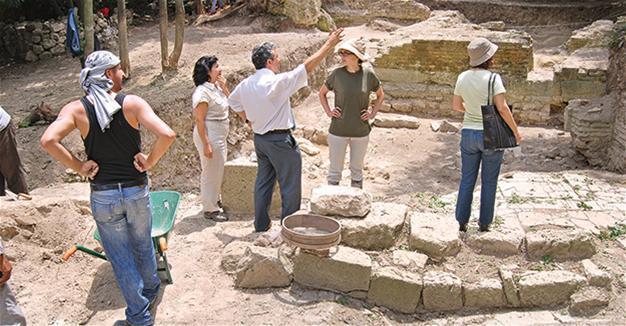Bathonea excavations aim to shed light on historic Istanbul quakes
KOCAELİ – Anadolu Agency

AA photo
Archaeological excavations carried out on the coast of the Küçükçekmece Lake in Istanbul’s Avcılar district by Kocaeli University aim to shed light on the history of earthquakes in Istanbul.Within the scope of excavations at the Bathonea ancient site, ongoing for over six years, traces of earthquakes are being examined under the chairmanship of Professor Şerif Barış, the head of Kocaeli University’s Earth and Space Sciences Research Center.
Barış said they could see the dimensions of underground cities, their roads and structures thanks to geophysical methods used in archaeological fields.
He said collaboration between geologists and archaeologists had accelerated in Turkey since 2008.
“Collaborating with the head of excavations, Associate Professor Şengül Aydıngün, in an important field like Küçükçekmece will be a very good model for both archaeological and geophysical circles. Such collaborations, namely archaeology and geophysics, are not common in Turkey. Both teams are working hard. We have German partners and I hope we will have very good results,” Barış added.
He said they used geophysical technics to discover the structures in ancient cities and to identify damage caused by earthquakes in those cities.
“During a visit to the excavation field in 2012, we obtained very important information like damage and loss of lives caused by earthquakes at a church, which was unearthed at the beginning of excavations,” Barış said.
“The bones of three bodies were found under the structure, as well as coins from the Justinian era. This showed us that one of the big Istanbul earthquakes, which occurred in 557 AD, also gave great damage to the Hagia Sophia. The foundations of all structures in Küçükçekmece collapsed. We also found that a large monumental structure in the excavation field received great damage from an earthquake in the past,” he added.
“Cracks occurred on the walls of some big structures, and later earthquakes caused great damage in Istanbul in the 6th, 10th and 11th centuries,” Barış said.
He noted that they found that a particularly large earthquake occurred in Istanbul in 1509, known as the “small doomsday.”
Discussions on quakes before 1500
Works are continuing at the Küçükçekmece Lake basin to determine the age of fault lines and damage caused by quakes over the years.
“According to information we have, the earthquake in 557 AD caused very big damage in the structures in the Bathonea field. Researches are continuing to find damage caused by other quakes too. There are discussions about the location and magnitude of quakes that occurred before 1500, and if we can find traces of more structures we will be able to find out the dimension of damage,” Barış said.
“If we reveal the age and traces of quakes that affected Istanbul throughout its history, we can eliminate the uncertainty in their formation. If you know the past, you can predict the future. Nature has a rule that if a disaster occurs in a place, it will reoccur in the same place. The possibility of these earthquakes in the same region is clear. If a 7.5-magnitude quake occurs in a place every 400 years, this means it will reoccur after 400 years. Four different earthquakes occurred in Marmara over a century. We need to know their locations, so we can predict where the next quake will occur,” he added.
















